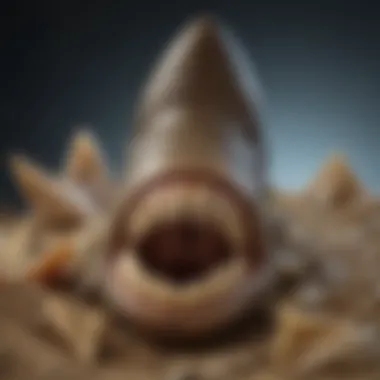Unveiling the Enigmatic Universe of Shark Teeth: An In-Depth Exploration


The Geology of Shark Teeth
Shark teeth are captivating geological artifacts that offer a window into the past. Understanding the rocks and fossils associated with these treasures is fundamental for collectors. When identifying shark teeth, it is crucial to recognize the different types of rocks and fossils they may be embedded in. Fossils in sedimentary rocks, such as limestone or shale, are common locations to find shark teeth. Look for distinct characteristics like serrations, root shapes, and enamel patterns to differentiate between species. Utilizing tools like magnifying glasses and dental tools can aid in the meticulous identification process.
Unveiling Collecting Techniques
Unearthing shark teeth requires patience and precision to safeguard these delicate specimens. Collectors should adhere to best practices, such as obtaining necessary permits and permissions before excavating. Prime collecting sites along coastlines or in fossil-rich areas yield optimal results. Safety measures, like wearing protective gear and using gentle extraction methods, prevent damage to the specimens and surrounding environment.
Mastery in Preservation
Preserving shark teeth involves meticulous techniques to maintain their pristine condition for years to come. Employ methods like cleaning with a soft brush or mild soap to remove dirt or debris without harming the specimen. Utilize proper storage containers, such as acid-free paper or foam padding, to prevent deterioration over time. For display, consider creative ideas like shadow boxes or glass cases to showcase the diversity and beauty of shark teeth.
Journeying Through Geological Insights
Exploring the geological origins of shark teeth unveils a rich tapestry of history and significance. These fossils provide insights into past geological formations and processes, shaping our understanding of ancient marine ecosystems. Delve into notable discoveries that have broadened scientific knowledge, showcasing the value of shark teeth in deciphering Earth's geological timeline.
Introduction to Shark Teeth
In this section, we embark on a fascinating journey through the intricate world of shark teeth. Exploring the different facets of shark teeth proves to be not only intriguing but also highly informative. Understanding the various types, formation processes, historical significance, and modern-day applications of these teeth allows us to delve deeper into the realm of marine biology and paleontology. Through a meticulous examination of shark teeth, we unravel the mysteries that these specimens hold, shedding light on their profound importance in the natural world.
An Overview of Shark Tooth
Different Types of Shark Teeth
Diving into the realm of shark teeth, we encounter a dazzling array of forms and functions. From the serrated edges of tiger shark teeth to the needle-like points of mako shark teeth, each type serves a unique purpose in the predator's arsenal. The diversity in shapes and sizes reflects the specialized roles these teeth play in the shark's feeding habits. By exploring the different types of shark teeth, we gain valuable insights into the evolutionary adaptations that have helped sharks thrive in diverse marine ecosystems.
Importance in Shark Biology
The significance of shark teeth in the realm of marine biology cannot be overstated. These teeth are not merely tools for predation but also windows into the evolutionary history of these ancient creatures. Understanding how shark teeth have evolved over millions of years provides crucial insights into the adaptive strategies that have allowed sharks to inhabit oceans across the globe. By unraveling the secrets held within shark teeth, scientists can piece together the puzzle of shark biology and behavior, paving the way for groundbreaking discoveries.


Historical Significance
Tracing back through the annals of history, we uncover the deep-rooted significance of shark teeth in various cultures and civilizations. From ancient talismans to symbols of strength and protection, shark teeth have played diverse roles in human societies. Their storied past is a testament to the enduring allure and mystique that surround these remarkable specimens. By examining the historical significance of shark teeth, we bridge the gap between the past and the present, gaining a deeper appreciation for these enigmatic artifacts.
Formation of Shark Teeth
Development Process
The development process of shark teeth is a marvel of natural engineering. Starting as tiny structures within the shark's jaw, these teeth undergo a complex series of transformations before emerging as formidable tools for predation. The intricate process of tooth development highlights the precision and adaptability of sharks' biological systems, showcasing nature's ingenuity at its finest. By unraveling the nuances of this developmental journey, we gain a profound appreciation for the complexity of tooth formation in these ancient predators.
Composition and Structure
Delving into the composition and structure of shark teeth offers a glimpse into the remarkable adaptations that make these specimens so formidable. Composed of one of the hardest substances in the animal kingdom, shark teeth are finely tuned for slicing through flesh and crushing shells with ease. The unique structural features of these teeth reflect millions of years of evolutionary fine-tuning, embodying the perfect balance of strength and flexibility. By examining the composition and structure of shark teeth, we unravel the secrets behind their unparalleled durability and efficacy.
Adaptations for Predation
The adaptations that make shark teeth such effective tools for predation are a testament to the evolutionary forces that have shaped these apex predators. From razor-sharp edges to serrated surfaces, these teeth are optimized for capturing and consuming prey in a wide range of marine environments. The adaptations for predation seen in shark teeth exemplify the intricate dance between form and function in the natural world, showcasing how specific traits have evolved to confer optimal advantages in the relentless struggle for survival. By scrutinizing these adaptations, we gain a deeper understanding of the evolutionary strategies that have made sharks such efficient hunters.
Classification of Shark Teeth
Based on Shape and Function
The classification of shark teeth based on their shape and function offers valuable insights into the diverse roles these specimens play in the predator's life. From crushing molars to piercing incisors, each type of tooth serves a specific purpose in the shark's feeding ecology. By categorizing shark teeth according to their morphology and role in the predator's diet, we can discern patterns in tooth evolution and ecological specialization. This classification system provides a framework for understanding how different shark species have adapted to exploit distinct niches in their marine habitats.
Notable Examples
Examining notable examples of shark teeth allows us to appreciate the incredible diversity and complexity within this category of biological structures. From the iconic triangular teeth of the great white shark to the peculiar spiraled teeth of the helicoprion, each specimen showcases the remarkable adaptations that sharks have evolved over millions of years. By highlighting these notable examples, we gain a deeper appreciation for the sheer variety of tooth forms seen across different shark species, illuminating the evolutionary pathways that have led to such spectacular dental diversity.
Rare and Valuable Specimens
Rare and valuable shark teeth hold a special place in the hearts of collectors and enthusiasts worldwide. These specimens, with their unique shapes, sizes, and histories, are prized for their scarcity and intrinsic beauty. From fossilized megalodon teeth to gem-like tiger shark teeth, rare specimens capture the imagination and spark the sense of wonder that drives collectors to seek out these treasures. By exploring these rare and valuable specimens, we uncover the rich tapestry of stories and secrets that make shark teeth such captivating objects of fascination and admiration.


Evolutionary History
Shark teeth have a rich evolutionary history that provides invaluable insights into the development and adaptation of these creatures over millions of years. Understanding the evolution of shark teeth enhances our knowledge of their predatory behavior, survival strategies, and ecological roles. By studying ancient shark teeth, scientists can trace the lineage of various shark species, uncovering key evolutionary patterns and adaptations that have enabled these apex predators to thrive in diverse marine environments. The evolutionary history of shark teeth offers a fascinating glimpse into the sophisticated mechanisms that have shaped these formidable creatures into the apex predators we recognize today.## Ancient Shark Teeth
Prehistoric Shark Species
Prehistoric shark species represent ancient marine creatures that roamed the oceans during different geological periods. These creatures, such as the Megalodon and Helicoprion, showcase remarkable diversity in tooth morphology and structure, reflecting the specialized feeding behaviors and ecological niches they occupied. The fossilized remains of prehistoric shark teeth provide archeologists and paleontologists with invaluable data for reconstructing past marine ecosystems and understanding the evolutionary trajectories of modern shark species. Prehistoric shark teeth serve as crucial links to our understanding of ancient marine biodiversity and the evolutionary processes that have shaped the oceans over millions of years.### Paleontological Discoveries
Paleontological discoveries related to shark teeth offer unique insights into the ancient environments and ecosystems that these creatures inhabited. Fossilized shark teeth found in sedimentary rocks provide crucial clues about the distribution, abundance, and diversity of shark species in prehistoric times. By analyzing paleontological discoveries, researchers can unravel the intricate relationships between ancient sharks and their prey, as well as the environmental conditions that influenced their evolution. Paleontological studies of shark teeth contribute significantly to our knowledge of past marine life and play a vital role in reconstructing the evolutionary history of shark species.### Evolutionary Adaptations
The evolutionary adaptations of shark teeth represent a fascinating aspect of their biological and ecological success. Through millions of years of natural selection, shark teeth have evolved diverse shapes, sizes, and serrations tailored to specific feeding behaviors and dietary preferences. These adaptations allow sharks to effectively capture, manipulate, and consume a wide range of prey items in their respective habitats. By examining the evolutionary adaptations of shark teeth, scientists can gain valuable insights into the selective pressures and environmental challenges that have driven the diversification of these iconic marine predators.
Modern Applications
Shark teeth hold a crucial role in the realm of modern applications, especially in scientific research, biomedical advancements, and conservation efforts. Understanding the various applications of shark teeth provides insights into their biological significance and potential benefits to various fields. From aiding in evolutionary studies to serving as biomimetic models for medical innovations, shark teeth offer a plethora of possibilities for researchers and scientists. The intersection of science and nature through shark teeth opens up avenues for exploration and discovery, shaping contemporary research endeavors.
Shark Teeth in Science
Research and Study
The scientific exploration of shark teeth is fundamental to unlocking the mysteries of these apex predators' evolutionary biology. Research and study on shark teeth facilitate a deeper comprehension of shark species diversity, feeding behaviors, and ecological roles. By analyzing the structure and composition of shark teeth, researchers can glean insights into shark adaptation mechanisms and ancient feeding habits. Additionally, the study of shark teeth assists in fossil classification and paleontological interpretations, contributing significantly to our understanding of prehistoric marine ecosystems.
Biomedical Applications
The biomedical applications of shark teeth are poised to revolutionize medical practices and technological advancements. Shark teeth's unique morphological features, such as hardness and durability, make them valuable resources for developing bio-inspired materials and tools. Biomedical experts are exploring the use of shark teeth in prosthetics, surgical instruments, and drug delivery systems due to their biocompatibility and structural integrity. Furthermore, the antimicrobial properties found in shark teeth are being investigated for potential applications in combating bacterial infections and enhancing medical treatments.
Conservation Efforts
Shark teeth play a critical role in raising awareness about marine conservation and environmental stewardship. Conservation efforts focused on preserving shark populations and their habitats are essential for ensuring the sustainability of ocean ecosystems. By studying shark teeth remnants, conservationists can assess historical population trends, understand the impact of human activities on shark species, and advocate for protective measures. Promoting conservation through the symbolic significance of shark teeth aids in fostering public engagement and support for marine conservation initiatives.
Commercial Trade
In the commercial trade sector, the market trends surrounding shark teeth reflect the evolving demand for marine artifacts and collectibles. Market trends indicate a growing interest in shark teeth among collectors, museums, and enthusiasts, driving sales and exchanges of rare specimens. The unique characteristics and historical value associated with shark teeth make them sought-after commodities in the global market. However, ethical concerns regarding sustainable sourcing practices and wildlife trade regulations are garnering attention within the commercial trade of shark teeth, prompting discussions on responsible consumption and conservation practices.
Ethical Concerns


Ethical considerations surrounding the trade and collection of shark teeth raise questions about the ethical sourcing, trading, and display of these marine artifacts. As the demand for shark teeth rises, concerns regarding sustainable harvesting practices and ethical procurement methods have come to the forefront. Addressing ethical concerns related to wildlife trade and cultural heritage preservation is imperative for promoting responsible collection and trade practices, ensuring the long-term viability of shark populations and marine ecosystems. By fostering ethical awareness and accountability within the commercial trade sector, stakeholders can uphold sustainable practices and uphold conservation principles.
Regulations and Laws
Regulations and laws governing the trade and possession of shark teeth are instrumental in protecting endangered shark species and regulating the commercial exploitation of marine resources. Legal frameworks aim to prevent illegal trade, enforce sustainable harvesting practices, and combat wildlife trafficking activities that threaten shark populations. Implementing strict regulations and compliance measures within the commercial trade of shark teeth is essential for mitigating conservation risks, preserving biodiversity, and upholding wildlife protection laws. By adhering to established regulations and advocating for stringent enforcement, stakeholders can contribute to the conservation and sustainable management of shark populations.
Collector's Guide
Shark teeth collection is a compelling aspect discussed in the comprehensive guide on shark teeth. It holds significant importance in understanding the different types of shark teeth, their historical context, and their relevance in modern applications. By focusing on collector's guide, enthusiasts of shark teeth, especially rock and fossil collectors, can glean valuable insights into the art of collecting and preserving these prized possessions. The collector's guide section serves as a foundational resource for individuals looking to embark on their journey in shark teeth collection, offering tips, techniques, and methods for a successful and enjoyable experience.
Tips for Collecting Shark Teeth
Hunting Locations
Hunting locations play a pivotal role in the success of shark teeth collection. They are crucial elements that determine the quality and diversity of specimens that collectors may find. Popular hunting locations often include beaches with rich fossil beds, riverbanks with exposed sedimentary layers, or even underwater sites where ancient shark teeth lay preserved. These locations offer enthusiasts a prime opportunity to discover a wide array of shark teeth, enhancing their collection with rare and valuable finds. However, the accessibility and legality of these hunting locations may vary, posing challenges for collectors in their pursuit of shark teeth.
Identification Techniques
Identification techniques are fundamental tools for collectors to differentiate between various types of shark teeth. By mastering these techniques, enthusiasts can accurately classify and catalog their finds, enabling them to expand their knowledge and appreciation of different species. From observing the shape and serration patterns to utilizing specialized guides and resources, identification techniques facilitate a deeper understanding of the unique characteristics of each shark tooth. However, the complexity and variability of shark teeth morphology require meticulous attention to detail and continuous learning to become proficient in identification.
Preservation Methods
Preservation methods are essential for maintaining the integrity and longevity of shark teeth collections. By adopting proper preservation techniques, collectors can prevent degradation, discoloration, or damage to their specimens over time. Common preservation methods include cleaning the teeth with gentle solutions, storing them in controlled environments to avoid moisture or temperature fluctuations, and using protective display cases to shield them from environmental factors. These methods ensure that shark teeth remain pristine and visually appealing, preserving their scientific and aesthetic value for future generations.
Display and Conservation
Artistic Presentations
Artistic presentations offer collectors a creative outlet to showcase their shark teeth collections in visually appealing and informative displays. From themed arrangements to custom mounts, artistic presentations elevate the aesthetic appeal of shark teeth, transforming them into captivating works of art. By incorporating artistic elements, collectors can not only preserve the scientific significance of their specimens but also express their passion for these prehistoric treasures in unique and engaging ways. However, striking a balance between artistic flair and preservation requirements is crucial to maintain the authenticity and educational value of the displays.
Storage Solutions
Effective storage solutions are essential for organizing and protecting shark teeth collections. Proper storage helps prevent damage, loss, or deterioration of specimens, ensuring their long-term preservation and usability. Common storage solutions include using archival boxes with padded compartments, labeling specimens with relevant information, and implementing systematic inventory management practices. These solutions enable collectors to safeguard their shark teeth collections while facilitating easy access for study, research, or display purposes.
Preventing Deterioration
Preventing deterioration is a critical aspect of conservation efforts aimed at preserving shark teeth collections for future generations. By implementing preventive measures, collectors can mitigate factors that contribute to deterioration, such as exposure to sunlight, humidity, or contaminants. Regular inspection, cleaning, and maintenance routines help identify and address potential issues, ensuring the longevity and integrity of shark teeth specimens. Additionally, engaging in ethical collection practices and adhering to conservation guidelines further contributes to preventing deterioration and promoting sustainable stewardship of these precious artifacts.







